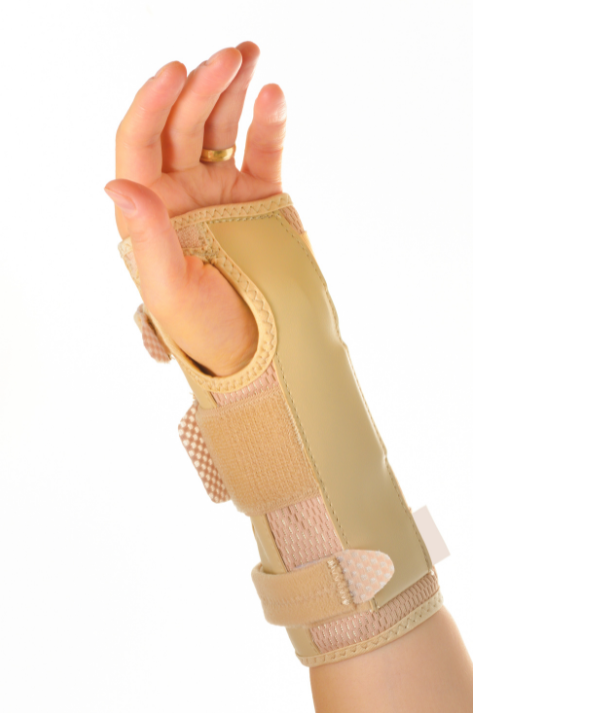Carpal Tunnel Syndrome Treatment: The Impact of Wrist Bracing
Carpal Tunnel Syndrome (CTS) is a prevalent condition that challenges patients and healthcare professionals. Evidence-based chiropractors may utilize conservative treatments to alleviate symptoms, avoiding surgical interventions. One such approach gaining attention is using wrist splints, specifically those incorporating the metacarpophalangeal (MCP) joints. In this blog post, we delve into the role of wrist splints in managing CTS and highlight the need for evidence-based chiropractors to consider this new brace as a valuable component of their treatment approach.
Did You Know…
Carpal Tunnel Syndrome is by far the most common peripheral nerve entrapment, affecting one in ten adults at some point in their lifetime. (1)
The lifetime risk increases to an astonishing 84% in diabetics. (2)
Paresthesias involving the palmar aspect of the first 3 ½ digits with nocturnal awakening is 77.4% sensitive for the diagnosis of CTS. (3)
The mobility of the entire median nerve was significantly restricted in cases of CTS compared to healthy participants. (4)
The Basics of Wrist Splinting
Traditional wrist splints have long been recommended for managing CTS by maintaining the wrist in a neutral position. This neutral position is essential, as it minimizes pressure on the carpal tunnel, a key factor in relieving symptoms. The increased pressure within the carpal tunnel associated with flexed or extended wrists emphasizes the importance of this neutral positioning. While splints may limit daily activities, they are often prescribed during sleep when the wrist naturally assumes a flexed position, intensifying carpal tunnel pressure.
Addressing Finger Motion in CTS Bracing
The traditional wrist-only splints, however, may have limitations in their effectiveness. Active finger flexion can cause lumbrical muscles to intrude into the carpal tunnel, elevating pressure and compressing the median nerve. To enhance the efficacy of splinting, chiropractors need to address this aspect and consider bracing options that limit both wrist and finger motion.
A recent study by Nadar et al. (2023) sheds light on the practical and effective use of splints in managing CTS. The study found that a wrist splint incorporating the MCP joints is more effective than the traditional wrist-only splint. The improvements persisted even after six months of intervention, suggesting a long-lasting impact. This specific splinting approach not only reduced disability but also facilitated a quicker return to work, potentially lowering associated costs. (5)
Considerations for Evidence-Based Chiropractors
While the study by Nadar et al. provides valuable insights, a quick review of the literature found three more studies with similar results! (6-8) All articles support the notion that splints restricting both the wrist and MCP joints yield better outcomes than wrist-only splints. However, it's crucial to note that some of these studies permitted daytime hand use, potentially limiting the results. Future studies exploring the impact of splinting throughout the day may provide a more comprehensive understanding of its effectiveness.
Also, don’t forget about manipulation. Here is a great video by Corey Campbell (www.motionpalpation.org) on manipulation strategies for the wrist.
Practical Application
With this new information, evidence-based chiropractors are encouraged to consider incorporating wrist splints that include the MCP joints in their treatment plans for CTS patients. These splints, readily available at a manageable price on platforms like Amazon, offer a practical and effective intervention option. It's essential to assess individual patient needs and lifestyle factors to determine the most suitable bracing approach.
If you’d like to explore more INFORMATION and VIDEOS on treatment strategies like nerve flossing, soft tissue manipulation, wrist manipulation, and at-home rehabilitation programs. We invite you to check out the condition reference within ChiroUp.
If you are not a ChiroUp subscriber, now is the time to sign up!
-
Schmid AB, Fundaun J, Tampin B. Entrapment neuropathies: a contemporary approach to pathophysiology, clinical assessment, and management. Pain Reports. 2020 Jul;5(4).
Singh R, Gamble G, Cundy T. Lifetime risk of symptomatic carpal tunnel syndrome in Type 1 diabetes. Diabetic medicine. 2005 May;22(5):625-30.
Hegmann KT, Merryweather A, Thiese MS, Kendall R, Garg A, Kapellusch J, Foster J, Drury D, Wood EM, Melhorn JM. Median Nerve Symptoms, Signs, and Electrodiagnostic Abnormalities Among Working Adults. JAAOS-Journal of the American Academy of Orthopaedic Surgeons. 2018 Aug 15;26(16):576-84.
Hara Y, Tajiri Y, Kawano K, Hoshikawa S. Evaluation of Restricted Motion Area of the Median Nerve in Patients with Carpal Tunnel Syndrome: A New Measurement Method Using an Ultrasonographic Video Image. The journal of hand surgery Asian-Pacific volume. 2021 Dec;26(4):635-43.
Nadar MS, Alotaibi N, Manee F. Efficacy of splinting the wrist and metacarpophalangeal joints for the treatment of Carpal tunnel syndrome: an assessor-blinded randomised controlled trial. BMJ open. 2023 Nov 1;13(11):e076961
Brininger TL, Rogers JC, Holm MB, et al.. Efficacy of a fabricated customized splint and tendon and nerve gliding exercises for the treatment of carpal tunnel syndrome: a randomized controlled trial. Arch Phys Med Rehabil 2007;88:1429–35.
Bulut GT, Caglar NS, Aytekin E, et al.. Comparison of static wrist splint with static wrist and metacarpophalangeal splint in carpal tunnel syndrome. J Back Musculoskelet Rehabil 2015;28:761–7.





